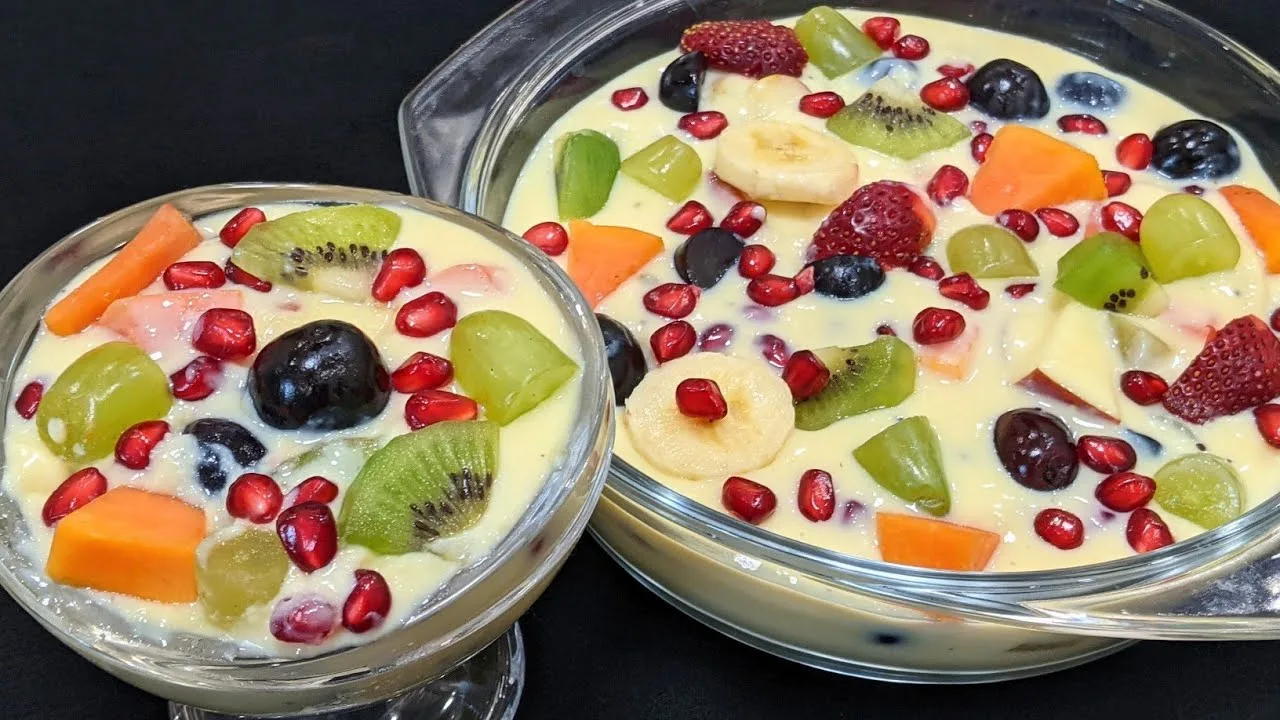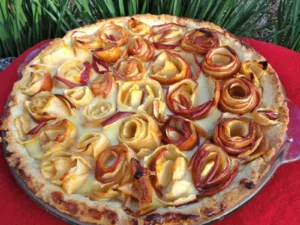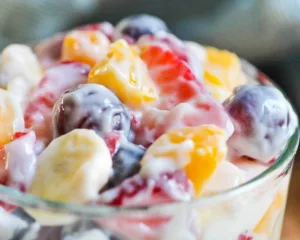Fruit custard salad is a delightful dessert that combines the goodness of fresh fruits with the creamy richness of custard. It’s a perfect treat for any occasion, whether it’s a family gathering, a picnic, or a potluck dinner.
1. Introduction to Fruit Custard Salad
Fruit custard salad is a popular dessert that is loved by people of all ages. It is made with a combination of fresh fruits and creamy custard, making it a refreshing and satisfying treat.
2. Health Benefits of Fruit Custard Salad
– Nutrient-rich ingredients
Fruit custard salad is packed with essential vitamins, minerals, and antioxidants from the fresh fruits used in the recipe. These nutrients are important for maintaining good health and well-being.
– Antioxidant properties
The fruits in fruit custard salad are rich in antioxidants, which help protect the body from damage caused by harmful free radicals. Antioxidants are also known to have anti-inflammatory properties, which can help reduce the risk of chronic diseases.
– Promotes digestion
The fiber in fruits helps promote healthy digestion and prevents constipation. Additionally, the probiotics in custard made from milk can help maintain a healthy balance of gut bacteria, further supporting digestive health.
3. Ingredients Needed for Fruit Custard Salad
To make fruit custard salad, you will need the following ingredients:
- Assorted fresh fruits (such as bananas, strawberries, kiwi, grapes, and mangoes)
- Custard powder
- Milk
- Sugar
- Vanilla extract (optional)
- Chopped nuts (optional, for garnish)
4. Step-by-Step Preparation Process
– Making custard
- In a saucepan, mix custard powder with a little milk to form a smooth paste.
- Heat the remaining milk in a separate saucepan until it starts to boil.
- Slowly pour the hot milk into the custard paste, stirring continuously to prevent lumps from forming.
- Return the mixture to the saucepan and cook over low heat until it thickens, stirring constantly.
- Once the custard has thickened, remove it from the heat and let it cool completely.
– Preparing fruits
- Wash and peel the fruits as necessary.
- Cut the fruits into bite-sized pieces and place them in a large bowl.
– Assembling the salad
- Once the custard has cooled, pour it over the chopped fruits in the bowl.
- Gently toss the fruits and custard together until they are evenly coated.
- Transfer the fruit custard salad to a serving dish and garnish with chopped nuts, if desired.
5. Tips for Making the Perfect Fruit Custard Salad
- Use ripe and seasonal fruits for the best flavor and texture.
- Adjust the sweetness of the custard according to your taste preferences.
- Chill the fruit custard salad in the refrigerator for at least an hour before serving for a refreshing treat.
- Garnish the salad with chopped nuts or fresh mint leaves for added texture and flavor.
6. Serving Suggestions
Serve fruit custard salad chilled as a refreshing dessert or snack. It can also be enjoyed as a light and healthy breakfast option or as a side dish with your favorite meal.
7. Frequently Asked Questions (FAQs)
Can I make fruit custard salad ahead of time?
Yes, you can prepare fruit custard salad ahead of time and store it in the refrigerator until ready to serve. Just be sure to cover it tightly to prevent it from drying out.
How long does fruit custard salad last in the refrigerator?
Fruit custard salad can be stored in the refrigerator for up to 2-3 days. However, it is best enjoyed fresh on the day it is made for optimal flavor and texture.
Can I use canned fruits for this salad?
While fresh fruits are preferred for their flavor and texture, you can use canned fruits as a convenient alternative. Just be sure to drain them well before adding them to the salad.
Is fruit custard salad suitable for people with dietary restrictions?
Fruit custard salad can be easily customized to accommodate various dietary restrictions. You can use dairy-free milk and custard powder for a vegan version, or adjust the sweetness level to suit your taste preferences.
Can I use flavored custard powder for this recipe?
Yes, you can use flavored custard powder such as vanilla or mango for a different twist on the classic fruit custard salad. Just keep in mind that the flavor of the custard will influence the overall taste of the salad.
8. Tips to enhance your fruit custard salad
- Experiment with Seasonal Fruits: Take advantage of seasonal fruits for the freshest and most flavorful salad. Incorporating fruits that are in season not only adds variety but also ensures optimal taste and texture.
- Layering for Visual Appeal: For a visually stunning presentation, consider layering the fruits and custard in a glass serving dish. This not only looks impressive but also allows each layer to shine through, creating a beautiful and appetizing dessert.
- Prevent Browning: To prevent fruits like apples and bananas from browning, you can toss them in a little lemon juice before adding them to the salad. The acidity of the lemon juice helps slow down the oxidation process, keeping your fruit custard salad looking fresh and vibrant.
- Balance Sweetness: If your fruits are particularly sweet, consider reducing the amount of sugar in the custard to maintain a perfect balance of sweetness. Alternatively, you can add a squeeze of lemon juice to the custard for a subtle tartness that complements the sweetness of the fruits.
- Add Texture with Granola: For an added crunch, sprinkle some granola over the fruit custard salad just before serving. The granola adds texture and a delightful nuttiness that complements the creamy custard and juicy fruits.
- Garnish with Fresh Herbs: Elevate the flavor profile of your fruit custard salad by garnishing it with fresh herbs like mint or basil. Not only do herbs add a pop of color, but they also impart a refreshing and aromatic touch to the dessert.
- Serve with a Side of Whipped Cream: For an extra indulgent treat, serve your fruit custard salad with a dollop of whipped cream on the side. The light and airy texture of the whipped cream adds richness and decadence to each bite, making it a truly irresistible dessert.
- Customize According to Dietary Preferences: Be mindful of any dietary restrictions or preferences when making fruit custard salad. You can easily customize the recipe to accommodate vegan, gluten-free, or dairy-free diets by using suitable alternatives for milk and custard powder.
By incorporating these tips, you can take your fruit custard salad to the next level and create a dessert that’s not only delicious but also visually stunning and perfectly balanced in flavor and texture. Enjoy experimenting with different fruits, flavors, and presentations to create your own signature fruit custard salad masterpiece!
9. Storage and leftovers tips for your Fruit Custard Salad
- Refrigeration: After making your Fruit Custard Salad, store any leftovers promptly in an airtight container and refrigerate them. Refrigeration helps preserve the freshness of the fruits and custard, ensuring they remain safe to eat for an extended period.
- Consume Within 2-3 Days: Fruit Custard Salad is best enjoyed fresh, so try to consume any leftovers within 2-3 days of preparation. As time passes, the fruits may start to lose their texture and flavor, and the custard may become watery.
- Stir Before Serving: Before serving leftover Fruit Custard Salad, give it a gentle stir to redistribute the custard and fruit juices. This helps ensure that each bite is flavorful and well-balanced.
- Avoid Freezing: While you can technically freeze Fruit Custard Salad, it’s not recommended as freezing can alter the texture and flavor of the fruits and custard. The fruits may become mushy upon thawing, and the custard may separate or become grainy.
- Repurpose Leftovers: Instead of letting leftovers go to waste, consider repurposing them into new dishes. Leftover Fruit Custard Salad can be blended into smoothies, used as a topping for pancakes or waffles, or mixed into yogurt for a tasty parfait.
- Layered Dessert Jars: Create layered dessert jars by alternating layers of leftover Fruit Custard Salad with granola, nuts, or crumbled cookies. This not only makes for a visually appealing dessert but also adds texture and crunch to each bite.
- Fruit Salad Popsicles: Turn leftover Fruit Custard Salad into refreshing popsicles by pouring the mixture into popsicle molds and freezing them until solid. These homemade popsicles are a fun and healthy treat for hot summer days.
- Check for Spoilage: Before consuming leftovers, always check for signs of spoilage such as an off odor, mold growth, or unusual texture. If the Fruit Custard Salad looks or smells questionable, it’s best to discard it to avoid the risk of foodborne illness.
10. Troubleshooting Tips
- Runny Custard: If your custard turns out too runny, it may not have been cooked for long enough or at too low a temperature. To fix this, return the custard to the saucepan and continue cooking it over low heat, stirring constantly, until it thickens to the desired consistency. Alternatively, you can mix a small amount of cornstarch with cold milk and stir it into the custard to help thicken it.
- Soggy Fruits: If your fruits become soggy after sitting in the custard for too long, it’s likely because they released excess moisture. To prevent this, try patting the fruits dry with paper towels before adding them to the custard. You can also opt for firmer fruits that hold their shape better when mixed with custard.
- Bland Flavor: If your Fruit Custard Salad lacks flavor, it may need a boost of sweetness or acidity. Try adding a splash of vanilla extract to the custard for added depth of flavor, or a squeeze of lemon juice to brighten the taste of the fruits. You can also sprinkle a pinch of cinnamon or nutmeg over the salad for a hint of warmth and spice.
- Custard Separation: If your custard separates or becomes grainy, it may have been cooked at too high a temperature or for too long. To prevent this, cook the custard over low to medium heat, stirring constantly, and remove it from the heat as soon as it thickens. If separation occurs, you can try whisking the custard vigorously to bring it back together, or blending it with an immersion blender for a smoother texture.
- Fruit Discoloration: If your fruits start to discolor after being mixed with the custard, it’s likely due to oxidation. To prevent this, you can toss the fruits in a mixture of lemon juice and water before adding them to the custard. The acid in the lemon juice helps inhibit oxidation and keeps the fruits looking fresh and vibrant.
- Unbalanced Texture: If your Fruit Custard Salad has an unbalanced texture, with some fruits being too soft and others too crunchy, try adjusting the size of the fruit pieces. Chopping the fruits into uniform bite-sized pieces ensures a consistent texture throughout the salad. You can also vary the types of fruits used to create a more diverse and interesting texture profile.
- Custard Overwhelming Flavor: If the custard overwhelms the flavor of the fruits in your salad, try reducing the amount of custard used or increasing the ratio of fruits to custard. You can also experiment with different flavors of custard, such as chocolate or butterscotch, to complement the fruits without overpowering them.
11. Conclusion
Fruit custard salad is a delicious and nutritious dessert that is perfect for any occasion. With its combination of fresh fruits and creamy custard, it is sure to be a hit with family and friends. Whether served as a refreshing dessert or a light breakfast option, fruit custard salad is a versatile dish that is easy to make and enjoy.
Get ready to impress your guests with this delightful dessert that combines the best of both worlds – fresh fruits and creamy custard!





